Enhanced Stabilization Effect of Cofactor Thiamine Pyrophosphate in the Covalent Immobilization of Formolase
Abstract
:1. Introduction
2. Results and Discussion
2.1. Preparation of the Purified Formolase and Nanocarriers
2.2. The Stabilization Effect of TPP on the Immobilization of Formolase
2.3. Immobilization of Formolase on the Fe3O4-SiO2-Epoxy Nanoparticles
2.4. Characterization of the Immobilized Formolase
3. Materials and Methods
3.1. Materials
3.2. Enzyme Assay
3.3. Preparation and Characterization of Fe3O4@SiO2-Epoxy Magnetic Nanoparticles
3.4. Preparation and Purification of Formolase
3.5. Immobilization of Formolase on Fe3O4@SiO2-Epoxy Nanoparticles
3.6. Characterization of the Immobilized Formolase
3.7. Molecular Docking of TPP into Formolase
4. Conclusions
Supplementary Materials
Author Contributions
Funding
Data Availability Statement
Conflicts of Interest
Abbreviations
| TPP | Thiamine pyrophosphate |
| FLS | Formolase |
| SDS-PAGE | Sodium dodecyl sulfate-polyacrylamide gel electrophoresis |
| IPTG | Isopropyl-β-D-thiogalactopyranoside |
| HEPES | 2-[4-(2-hydroxyethyl)piperazin-1-yl]ethanesulfonic acid |
| TEOS | Tetraethyl orthosilicate |
| PDB | Protein data bank |
References
- Meghwanshi, G.K.; Kaur, N.; Verma, S.; Dabi, N.K.; Vashishtha, A.; Charan, P.D.; Purohit, P.; Bhandari, H.S.; Bhojak, N.; Kumar, R. Enzymes for Pharmaceutical and Therapeutic Applications. Biotechnol. Appl. Biochem. 2020, 67, 586–601. [Google Scholar] [CrossRef] [PubMed]
- Yang, G.; Miton, C.M.; Tokuriki, N. A Mechanistic View of Enzyme Evolution. Protein Sci. 2020, 29, 1724–1747. [Google Scholar] [CrossRef] [PubMed]
- Vishnu Priya, B.; Sreenivasa Rao, D.H.; Gilani, R.; Lata, S.; Rai, N.; Akif, M.; Kumar Padhi, S. Enzyme Engineering Improves Catalytic Efficiency and Enantioselectivity of Hydroxynitrile Lyase for Promiscuous Retro-Nitroaldolase Activity. Bioorganic Chem. 2022, 120, 105594. [Google Scholar] [CrossRef] [PubMed]
- Eş, I.; Vieira, J.D.G.; Amaral, A.C. Principles, Techniques, and Applications of Biocatalyst Immobilization for Industrial Application. Appl. Microbiol. Biotechnol. 2015, 99, 2065–2082. [Google Scholar] [CrossRef] [PubMed]
- Bilal, M.; Rasheed, T.; Zhao, Y.; Iqbal, H.M.N.; Cui, J. “Smart” Chemistry and Its Application in Peroxidase Immobilization Using Different Support Materials. Int. J. Biol. Macromol. 2018, 119, 278–290. [Google Scholar] [CrossRef]
- Hartmann, M.; Jung, D. Biocatalysis with Enzymes Immobilized on Mesoporous Hosts: The Status Quo and Future Trends. J. Mater. Chem. 2010, 20, 844–857. [Google Scholar] [CrossRef]
- Teufl, M.; Zajc, C.U.; Traxlmayr, M.W. Engineering Strategies to Overcome the Stability–Function Trade-Off in Proteins. ACS Synth. Biol. 2022, 11, 1030–1039. [Google Scholar] [CrossRef]
- Hanefeld, U.; Gardossi, L.; Magner, E. Understanding Enzyme Immobilisation. Chem. Soc. Rev. 2009, 38, 453–468. [Google Scholar] [CrossRef]
- Zhu, C.-Y.; Li, F.-L.; Zhang, Y.-W.; Gupta, R.K.; Patel, S.K.S.; Lee, J.-K. Recent Strategies for the Immobilization of Therapeutic Enzymes. Polymers 2022, 14, 1409. [Google Scholar] [CrossRef]
- Jiang, X.-P.; Lu, T.-T.; Liu, C.-H.; Ling, X.-M.; Zhuang, M.-Y.; Zhang, J.-X.; Zhang, Y.-W. Immobilization of Dehydrogenase onto Epoxy-Functionalized Nanoparticles for Synthesis of (R)-Mandelic Acid. Int. J. Biol. Macromol. 2016, 88, 9–17. [Google Scholar] [CrossRef]
- Wang, K.; Zhao, L.; Li, T.; Wang, Q.; Ding, Z.; Dong, W. Selective Immobilization of His-Tagged Enzyme on Ni-Chelated Ion Exchange Resin and Its Application in Protein Purification. Int. J. Mol. Sci. 2023, 24, 3864. [Google Scholar] [CrossRef] [PubMed]
- Imam, H.T.; Marr, P.C.; Marr, A.C. Enzyme Entrapment, Biocatalyst Immobilization without Covalent Attachment. Green Chem. 2021, 23, 4980–5005. [Google Scholar] [CrossRef]
- Siegel, J.B.; Smith, A.L.; Poust, S.; Wargacki, A.J.; Bar-Even, A.; Louw, C.; Shen, B.W.; Eiben, C.B.; Tran, H.M.; Noor, E.; et al. Computational Protein Design Enables a Novel One-Carbon Assimilation Pathway. Proc. Natl. Acad. Sci. USA 2015, 112, 3704. [Google Scholar] [CrossRef] [PubMed]
- Wang, X.; Wang, Y.; Liu, J.; Li, Q.; Zhang, Z.; Zheng, P.; Lu, F.; Sun, J. Biological Conversion of Methanol by Evolved Escherichia coli Carrying a Linear Methanol Assimilation Pathway. Bioresour. Bioprocess. 2017, 4, 41. [Google Scholar] [CrossRef]
- Peng, K.; Guo, D.; Lou, Q.; Lu, X.; Cheng, J.; Qiao, J.; Lu, L.; Cai, T.; Liu, Y.; Jiang, H. Synthesis of Ligustrazine from Acetaldehyde by a Combined Biological-Chemical Approach. ACS Synth. Biol. 2020, 9, 2902–2908. [Google Scholar] [CrossRef]
- Li, X.-Y.; Huang, J.-Y.; Zhou, Q.; Xu, Y.-Y.; Prabhu, P.; Zhang, Y.-W. Immobilization of Alcohol Dehydrogenase, Acetaldehyde Lyase, and NADH Oxidase for Cascade Enzymatic Conversion of Ethanol to Acetoin. Energies 2022, 15, 4242. [Google Scholar] [CrossRef]
- Kondaveeti, S.; Park, G.D.; Shanmugam, R.; Pagolu, R.; Patel, S.K.S.; Bisht, A.; Kim, D.R.; Kang, Y.C.; Lee, J.-K. Investigating the Role of Metals Loaded on Nitrogen-Doped Carbon-Nanotube Electrodes in Electroenzymatic Alcohol Dehydrogenation. Appl. Catal. B Environ. 2022, 307, 121195. [Google Scholar] [CrossRef]
- Gupta, R.K.; Patel, S.K.S.; Lee, J.-K. Novel Cofactor Regeneration-Based Magnetic Metal-Organic Framework for Cascade Enzymatic Conversion of Biomass-Derived Bioethanol to Acetoin. Bioresour. Technol. 2024, 408, 131175. [Google Scholar] [CrossRef]
- Hu, G.; Li, Z.; Ma, D.; Ye, C.; Zhang, L.; Gao, C.; Liu, L.; Chen, X. Light-Driven CO2 Sequestration in Escherichia coli to Achieve Theoretical Yield of Chemicals. Nat. Catal. 2021, 4, 395–406. [Google Scholar] [CrossRef]
- Janzen, E.; Müller, M.; Kolter-Jung, D.; Kneen, M.M.; McLeish, M.J.; Pohl, M. Characterization of Benzaldehyde Lyase from Pseudomonas fluorescens: A Versatile Enzyme for Asymmetric C–C Bond Formation. Bioorganic Chem. 2006, 34, 345–361. [Google Scholar] [CrossRef]
- Costelloe, S.; Ward, J.; Dalby, P. Evolutionary Analysis of the TPP-Dependent Enzyme Family. J. Mol. Evol. 2008, 66, 36–49. [Google Scholar] [CrossRef] [PubMed]
- Mateo, C.; Grazu, V.; Palomo, J.M.; Lopez-Gallego, F.; Fernandez-Lafuente, R.; Guisan, J.M. Immobilization of Enzymes on Heterofunctional Epoxy Supports. Nat. Protoc. 2007, 2, 1022–1033. [Google Scholar] [CrossRef] [PubMed]
- Serra, I.; Benucci, I.; Robescu, M.; Lombardelli, C.; Esti, M.; Calvio, C.; Pregnolato, M.; Terreni, M.; Bavaro, T. Developing a Novel Enzyme Immobilization Process by Activation of Epoxy Carriers with Glucosamine for Pharmaceutical and Food Applications. Catalysts 2019, 9, 843. [Google Scholar] [CrossRef]
- Xu, K.; Chen, X.; Zheng, R.; Zheng, Y. Immobilization of Multi-Enzymes on Support Materials for Efficient Biocatalysis. Front. Bioeng. Biotechnol. 2020, 8, 660. [Google Scholar] [CrossRef] [PubMed]
- Rodríguez-Núñez, K.; Bernal, C.; Bolívar, J.M. Chapter 1—The Enzyme, the Support, and the Immobilization Strategy: The Key Findings to a Desirable Biocatalyst. In Biocatalyst Immobilization; Ferreira, M.L., Ed.; Foundations and Frontiers in Enzymology; Academic Press: Cambridge, MA, USA, 2023; pp. 1–16. ISBN 978-0-323-91317-1. [Google Scholar]
- Guisan, J.M.; López-Gallego, F.; Bolivar, J.M.; Rocha-Martín, J.; Fernandez-Lorente, G. The Science of Enzyme Immobilization. In Immobilization of Enzymes and Cells: Methods and Protocols; Guisan, J.M., Bolivar, J.M., López-Gallego, F., Rocha-Martín, J., Eds.; Springer: New York, NY, USA, 2020; pp. 1–26. ISBN 978-1-07-160215-7. [Google Scholar]
- Ulu, A.; Ozcan, I.; Koytepe, S.; Ates, B. Design of Epoxy-Functionalized Fe3O4@MCM-41 Core-Shell Nanoparticles for Enzyme Immobilization. Int. J. Biol. Macromol. 2018, 115, 1122–1130. [Google Scholar] [CrossRef]
- Hawkins, C.F.; Borges, A.; Perham, R.N. A Common Structural Motif in Thiamin Pyrophosphate-Binding Enzymes. FEBS Lett. 1989, 255, 77–82. [Google Scholar] [CrossRef]
- Thangaraj, B.; Jia, Z.; Dai, L.; Liu, D.; Du, W. Effect of Silica Coating on Fe3O4 Magnetic Nanoparticles for Lipase Immobilization and Their Application for Biodiesel Production. Arab. J. Chem. 2019, 12, 4694–4706. [Google Scholar] [CrossRef]
- Demir, A.S.; Seşenoglu, O.; Dünkelmann, P.; Müller, M. Benzaldehyde Lyase-Catalyzed Enantioselective Carboligation of Aromatic Aldehydes with Mono- and Dimethoxy Acetaldehyde. Org. Lett. 2003, 5, 2047–2050. [Google Scholar] [CrossRef]
- Solís-Calero, C.; Ortega-Castro, J.; Hernández-Laguna, A.; Muñoz, F. A Comparative DFT Study of the Schiff Base Formation from Acetaldehyde and Butylamine, Glycine and Phosphatidylethanolamine. Theor. Chem. Acc. 2012, 131, 1263. [Google Scholar] [CrossRef]
- Zhang, L.; Singh, R.; Sivakumar, D.; Guo, Z.; Li, J.; Chen, F.; He, Y.; Guan, X.; Kang, Y.C.; Lee, J.K. An Artificial Synthetic Pathway for Acetoin, 2,3-Butanediol, and 2-Butanol Production from Ethanol Using Cell Free Multi-Enzyme Catalysis. Green Chem. 2018, 20, 230–242. [Google Scholar] [CrossRef]
- Taiwo, A.E.; Madzimbamuto, T.N.; Ojumu, T.V. Optimization of Process Variables for Acetoin Production in a Bioreactor Using Taguchi Orthogonal Array Design. Heliyon 2020, 6, e05103. [Google Scholar] [CrossRef] [PubMed]
- Huang, J.-Y.; Yu, S.; Li, R.-F.; Han, K.-K.; Zhang, Y.-W. Fabrication of Fe3O4@SiO2@PDA-Ni2+ Nanoparticles for One-Step Affinity Immobilization and Purification of His-Tagged Glucose Dehydrogenase. Process Biochem. 2023, 128, 106–115. [Google Scholar] [CrossRef]
- Bradford, M.M. A Rapid and Sensitive Method for the Quantitation of Microgram Quantities of Protein Utilizing the Principle of Protein-Dye Binding. Anal. Biochem. 1976, 72, 248–254. [Google Scholar] [CrossRef] [PubMed]
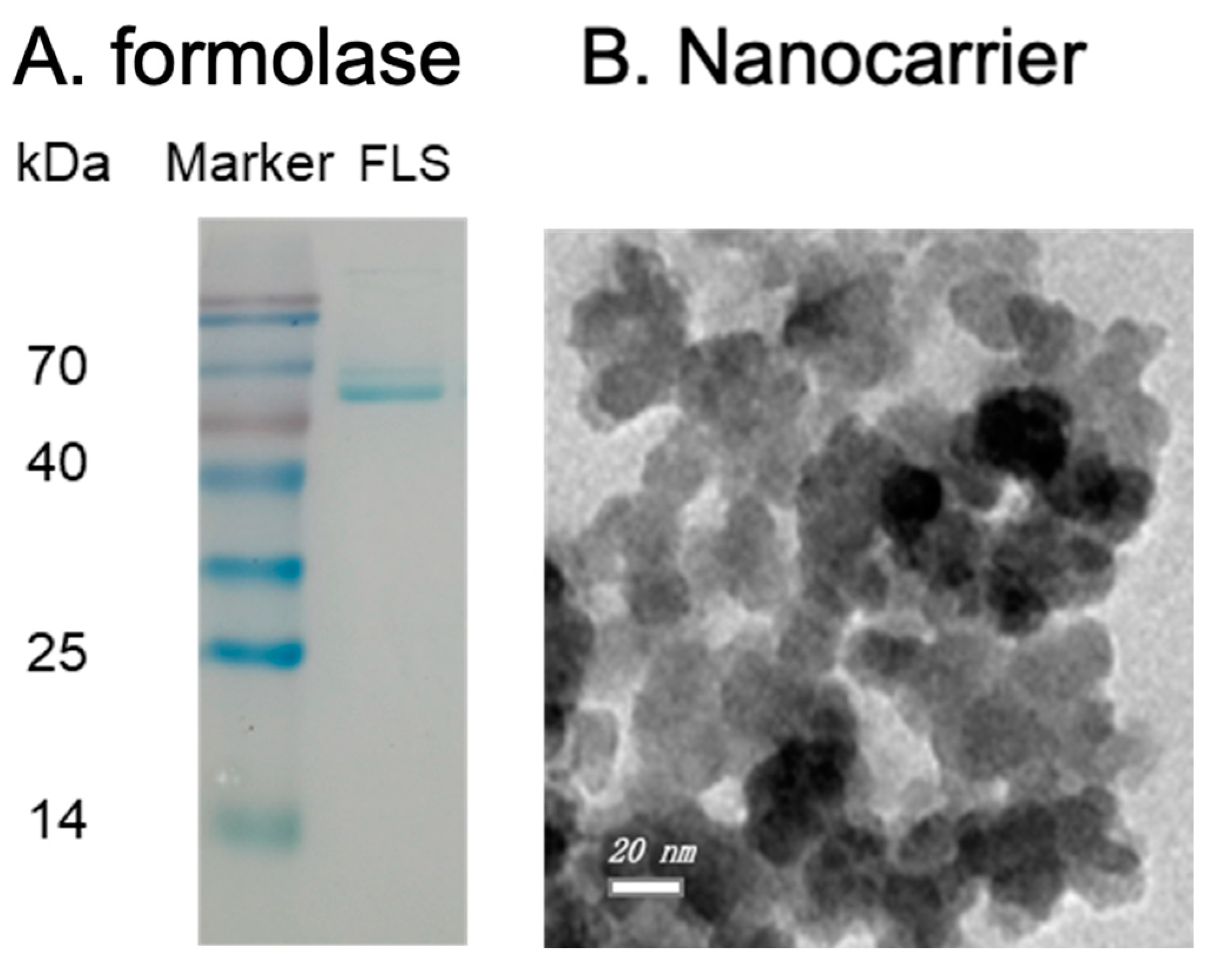
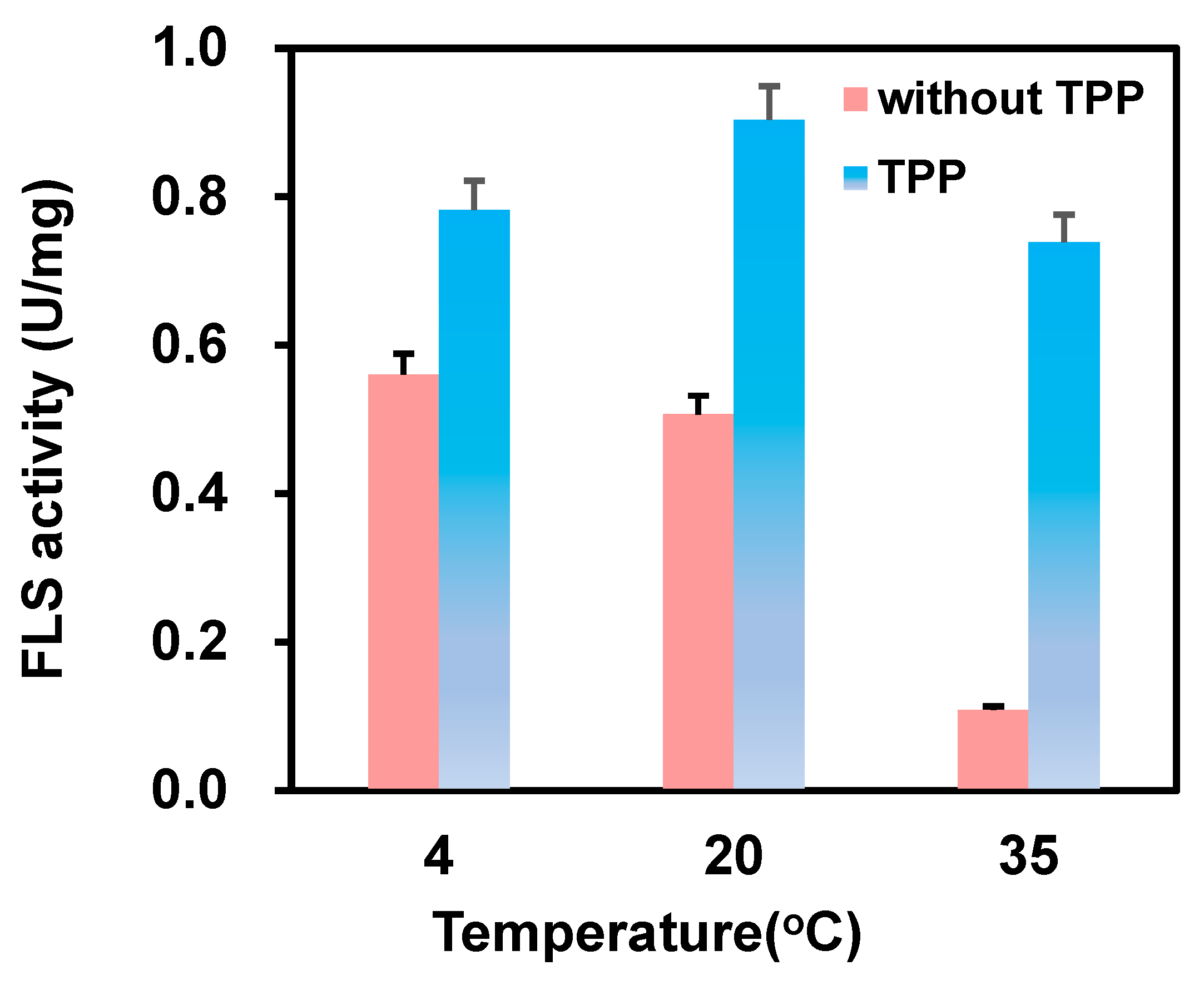
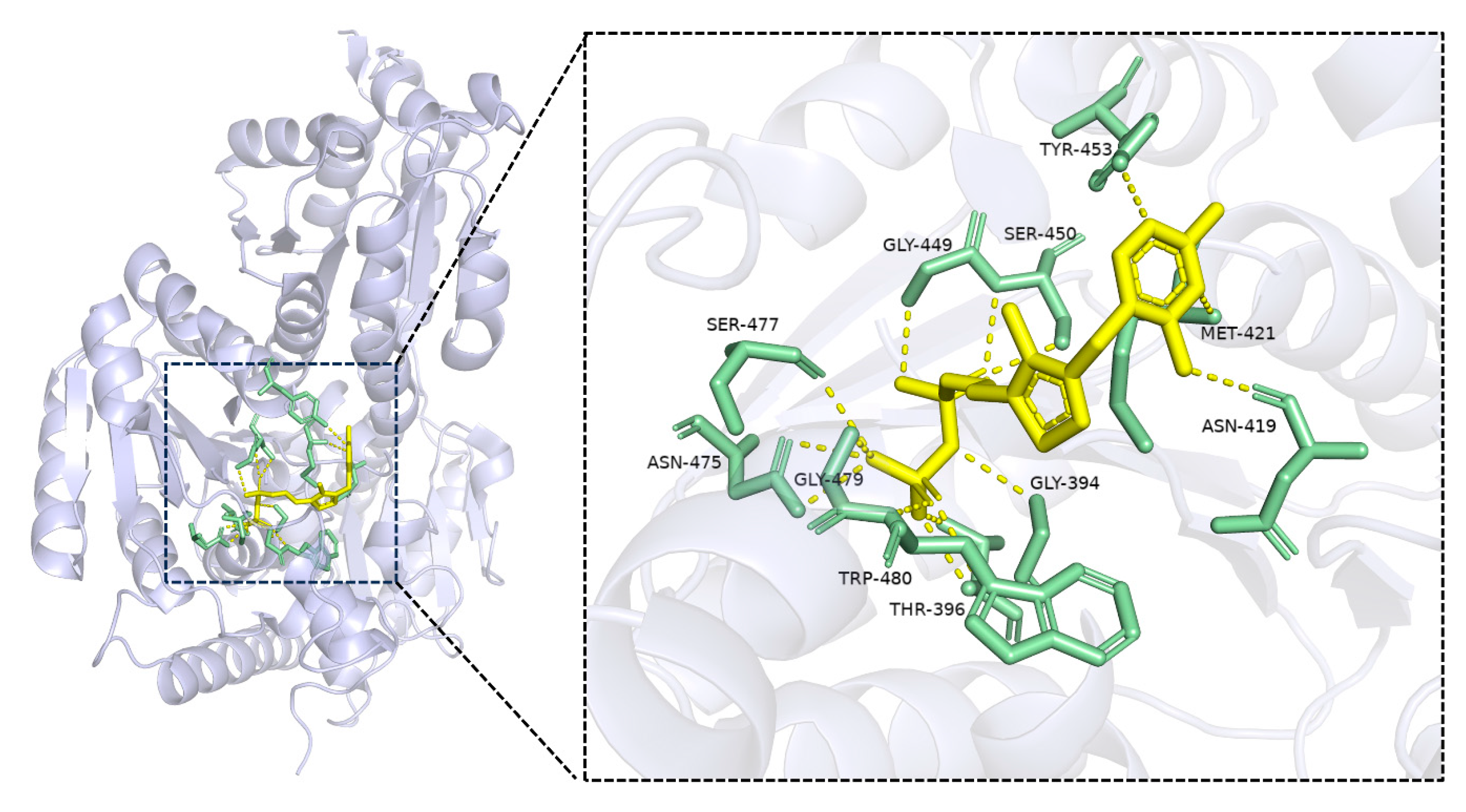
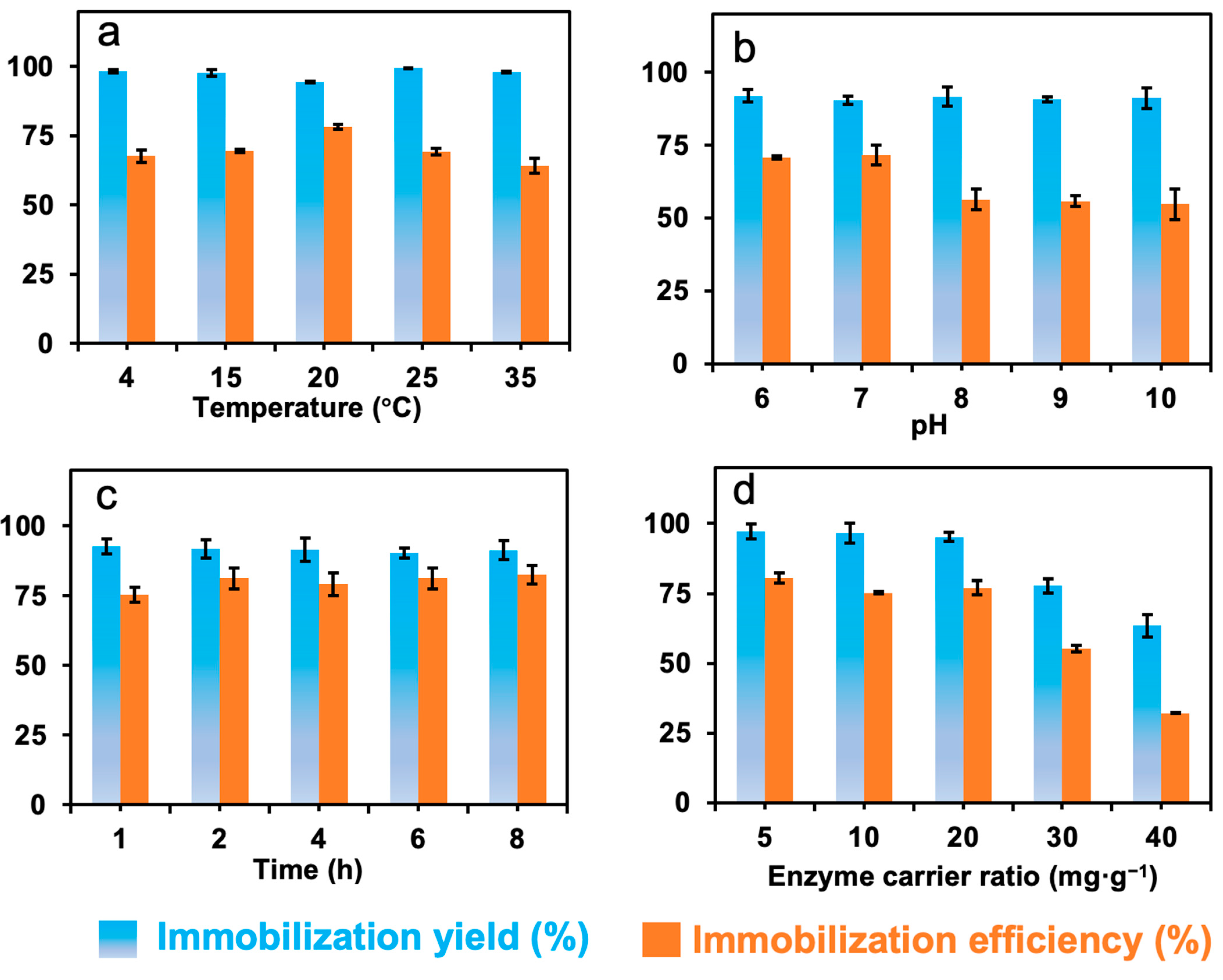

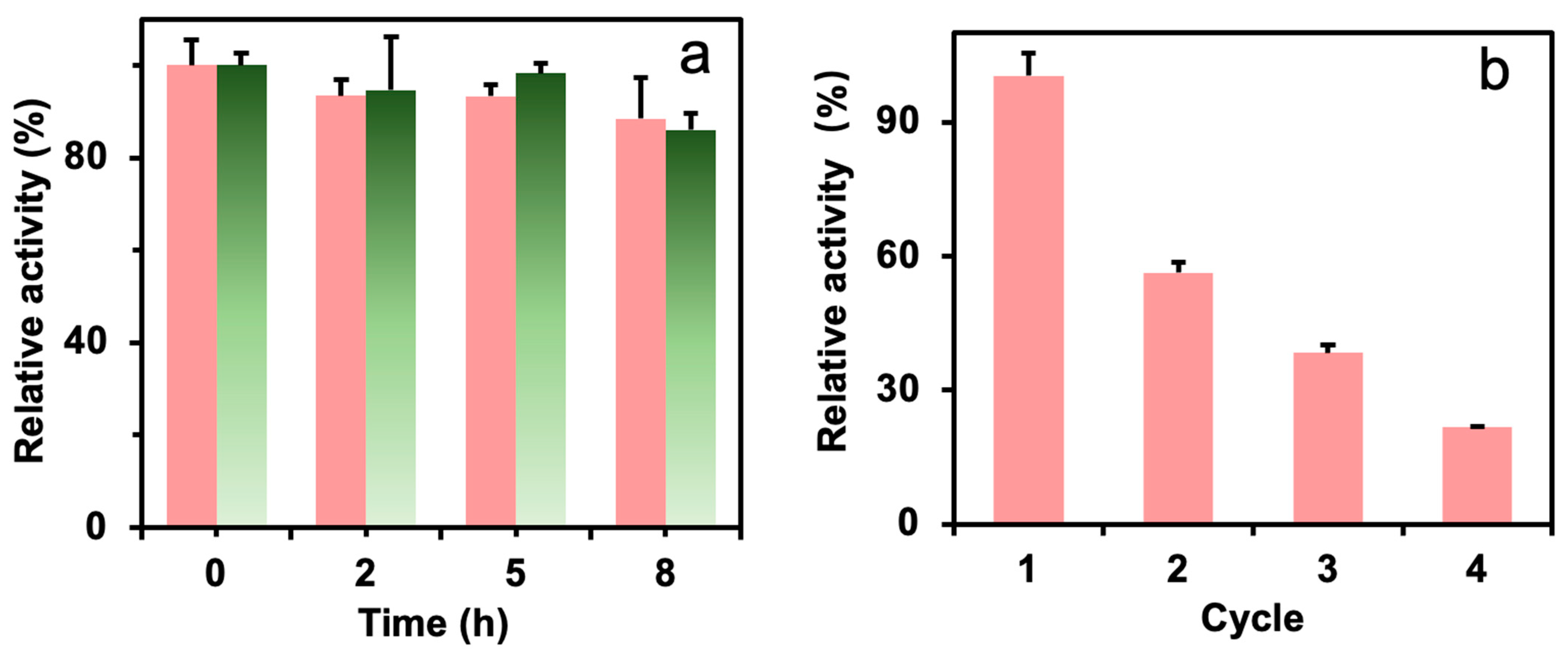
Disclaimer/Publisher’s Note: The statements, opinions and data contained in all publications are solely those of the individual author(s) and contributor(s) and not of MDPI and/or the editor(s). MDPI and/or the editor(s) disclaim responsibility for any injury to people or property resulting from any ideas, methods, instructions or products referred to in the content. |
© 2024 by the authors. Licensee MDPI, Basel, Switzerland. This article is an open access article distributed under the terms and conditions of the Creative Commons Attribution (CC BY) license (https://creativecommons.org/licenses/by/4.0/).
Share and Cite
Yu, S.; Li, X.-Y.; Si, W.-J.; Zhang, Y.-W. Enhanced Stabilization Effect of Cofactor Thiamine Pyrophosphate in the Covalent Immobilization of Formolase. Catalysts 2024, 14, 911. https://doi.org/10.3390/catal14120911
Yu S, Li X-Y, Si W-J, Zhang Y-W. Enhanced Stabilization Effect of Cofactor Thiamine Pyrophosphate in the Covalent Immobilization of Formolase. Catalysts. 2024; 14(12):911. https://doi.org/10.3390/catal14120911
Chicago/Turabian StyleYu, Shen, Xue-Yong Li, Wen-Jie Si, and Ye-Wang Zhang. 2024. "Enhanced Stabilization Effect of Cofactor Thiamine Pyrophosphate in the Covalent Immobilization of Formolase" Catalysts 14, no. 12: 911. https://doi.org/10.3390/catal14120911
APA StyleYu, S., Li, X.-Y., Si, W.-J., & Zhang, Y.-W. (2024). Enhanced Stabilization Effect of Cofactor Thiamine Pyrophosphate in the Covalent Immobilization of Formolase. Catalysts, 14(12), 911. https://doi.org/10.3390/catal14120911






